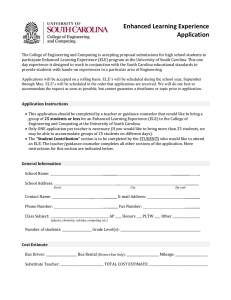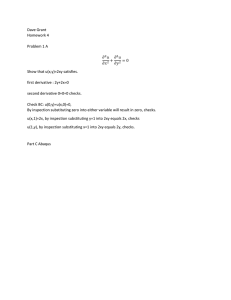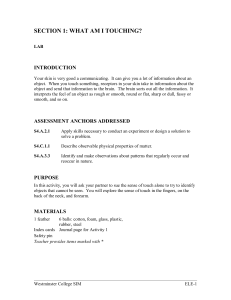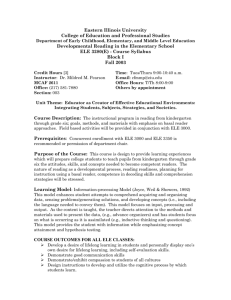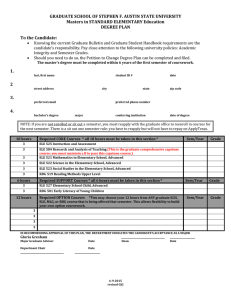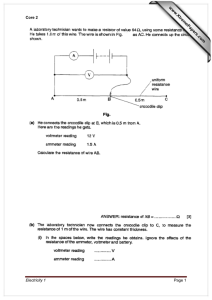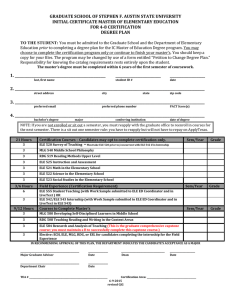Energy Systems Engineering: Thesis Option
advertisement
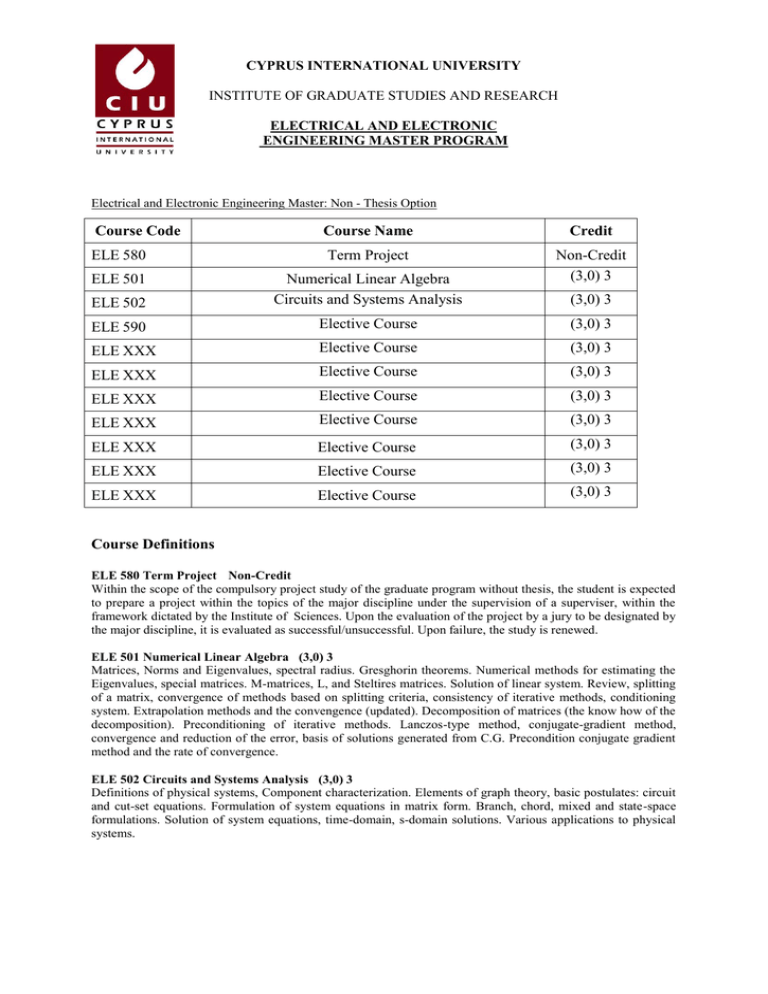
CYPRUS INTERNATIONAL UNIVERSITY INSTITUTE OF GRADUATE STUDIES AND RESEARCH ELECTRICAL AND ELECTRONIC ENGINEERING MASTER PROGRAM Electrical and Electronic Engineering Master: Non - Thesis Option Course Code Course Name Credit ELE 580 Term Project ELE 501 ELE 502 Numerical Linear Algebra Circuits and Systems Analysis Non-Credit (3,0) 3 ELE 590 Elective Course (3,0) 3 ELE XXX Elective Course (3,0) 3 ELE XXX Elective Course (3,0) 3 ELE XXX Elective Course (3,0) 3 ELE XXX Elective Course (3,0) 3 ELE XXX Elective Course (3,0) 3 ELE XXX Elective Course (3,0) 3 ELE XXX Elective Course (3,0) 3 (3,0) 3 Course Definitions ELE 580 Term Project Non-Credit Within the scope of the compulsory project study of the graduate program without thesis, the student is expected to prepare a project within the topics of the major discipline under the supervision of a superviser, within the framework dictated by the Institute of Sciences. Upon the evaluation of the project by a jury to be designated by the major discipline, it is evaluated as successful/unsuccessful. Upon failure, the study is renewed. ELE 501 Numerical Linear Algebra (3,0) 3 Matrices, Norms and Eigenvalues, spectral radius. Gresghorin theorems. Numerical methods for estimating the Eigenvalues, special matrices. M-matrices, L, and Steltires matrices. Solution of linear system. Review, splitting of a matrix, convergence of methods based on splitting criteria, consistency of iterative methods, conditioning system. Extrapolation methods and the convengence (updated). Decomposition of matrices (the know how of the decomposition). Preconditioning of iterative methods. Lanczos-type method, conjugate-gradient method, convergence and reduction of the error, basis of solutions generated from C.G. Precondition conjugate gradient method and the rate of convergence. ELE 502 Circuits and Systems Analysis (3,0) 3 Definitions of physical systems, Component characterization. Elements of graph theory, basic postulates: circuit and cut-set equations. Formulation of system equations in matrix form. Branch, chord, mixed and state-space formulations. Solution of system equations, time-domain, s-domain solutions. Various applications to physical systems. Elective Courses ELE 525 Advanced Digital Signal Processing (3,0) 3 Linear systems analysis, discrete time signals and systems, Z transforms, Properties, Realization structures for digital filters, Recursive and non-recursive functions, stability criteria, Design of low pass, high pass and band pass filters, frequency response shaping, window functions, finite word length effects, signal processing techniques for random signals, Discrete Fourier Transform Decimation in frequency and time, Fast Fourier Transforms, 2D signal processing. ELE 526 Digital Image Processing (3,0) 3 Characteristics of image signals, representation in time and frequency, spatial and temporal domains, digitizer, 2D, Z transforms, realization of digital image processing system 2D FFT, Discrete Cosine Transform, Spatial filtering techniques, pattern recognition, Edge detection and enhancement, contrast enhancement, histogram equalization, median filtering, image data compression. ELE 532 Advanced Antenna Theory (3,0) 3 Basic antenna parameters. Transmission loss, radar equation. Retarded potentials, thin linear wire antennas. Hertzian dipole, small dipole, finite length and half-wavelength dipoles. Vector potentials, field equivalence principle. Rectangular and circular apertures. Horns. Induced current, parabolic reflectors. Array antennas, uniform and non-uniform aperture distributions, scanning arrays, pattern synthesis, planar arrays. ELE 534 Numerical Methods in Electromagnetics (3,0) 3 Review of main analytical and numerical methods for field problems. Method of moments applied to static field, scattering and antenna problems. Hallen's and Pocklington's integral. The finite-difference method for static and time-varying fields. Variational methods, the Rayleigh-Ritz method. The finite-element method. Absorbing boundary conditions. ELE 537 Microwave Integrated Circuits (3,0) 3 Fundamentals of MICs; MIC technologies; coupled lines and directional couplers; filters and multiplexers; mixers; phase shifters; amplifiers; oscillators; T/R module; microwave systems. ELE 542 Advanced Industrial and Power Electronics (3,0) 3 Single-phase and three-phase controlled rectifiers, Distortion, displacement and power factor. Commutation overlap. Firing control. Voltage-fed inverters, the McMurray and McMurray-Bedford inverters. Voltage control in inverters, PWM control techniques. Current-fed inverters; load-commutated, force-commutated, autosequential-commutated inverters. DC and AC drives; scalar and vector control methods, slip power recovery control. ELE 544 Advances on VLSI Design (3,0) 3 Various aspects of the design stages of VLSI (Very Large Scale Integration). Mathematical background, combinatorics, graph theory and geometry. Layout and wire-routing problems of the design. Examples on computer networks and VLSI realization of neural networks. ELE 551 Vector Contro of A.C Machines (3,0) 3 Introduction. Space -Phasor models of A.C. Machines; The space - phasors of M.M.F.s and currents of the stator and rotor, Reference frames and flux-linkage space phasor models, Mathematical models of electrical and mechanical ports. Vector control of synchronous machines; The control of permanent- magnet synchronous machines with surface- mounted magnets and with interior magnets. The stator-flux oriented control in Cartesian koordinates, Vector control of salient pole machines, Vector control of reluctance machines. Vector control of Induction machines; Rotor-flux- oriented control, stator-flux-oriented control. The effect of magnetic saturation to the control. ELE 552 Advanced Electric Machinery and Drives Advanced (3,0) 3 Advanced electromechanics of rotating and linear machines. Topics include dynamic analysis of machines, reference frame transformations, reduced order models, models of mechanical loads, power electric drives for motors, and digital simulation of machines and electric drive systems. Applications discussed will include renewable energy and electric propulsion systems. ELE 553 Advanced Dynamics of Electrical Machines (3,0) 3 Electromechanical energy conversion, transformer dynamics, linear and nonlinear electromechanical systems, torque and force expressions, mathematical model of electromechanical system, transformations applied to induction machines, synchronous machines, single and multi-machine problems. ELE 554 High – Voltage Insulation Coordination (3,0) 3 Definitions and basic concepts, temporary overvoltages, load rejection, Ferranti effect, earth faults, symmetrical components, switching overvoltages, removal of a short circuit, transient recovery voltage (TRV), resistance switching, load switching, abnormal switching transients, current chopping, capacitance switching, switching of small inductive currents, ferroresonance, external overvoltages, traveling waves, disruptive discharge and withstand voltages, insulation coordination in high voltage electric power systems, protection against overvoltages, protective devices. ELE 555 High Voltage Underground Cables (3,0) 3 Types of power cable and definitions. Conductors and insulating materials for cables. Calculations of cable parameters. Design of cables: Electrical field distributions and electrical stress performance. Aging, electrical treeing and partial discharges in cables. Thermal characteristics and current carrying capacities of cables. Shorttime and short-circuit performance of cables. Cooling of cables. Cable losses. Transposition of cables. Interference and screening of cables. Corrosion and protection of cables. Cable manufacturing. Cable tests. Cable selection. Diagnosis and location of cable faults. Economics of cable. Cable accessories: terminations and joints. Special cables (direct-current cables, superconducting cables, gas insulated cables, cables with sodium conductor, extra high voltage cables, sea cables). Cable standards and specifications. ELE556 Switching Transiensts in Power (3,0) 3 Introduction, Transmission Line Parameters, effect of ground conductor on the series impedance and shunt admittance matrix, transformation methods for transient calculations used in power systems, single conductor energy system with ground return, modelling of multi conductor energy system with multi terminal components and transformation of P-matrix, interconnection of multi conductor systems with different characteristics, various applications of mathematical conductor modelling. ELE557 Power System Harmonics (3,0) 3 Definitions and power quality, nonlinear loads and system behavior, mathematical methods, harmonic producing networks (switched mode power converters, power electronic circuits in motor control, renewable energy production, arc-furnace, etc), distribution of harmonics in power system, modelling and simulation, parallel and series resonance, adverse effects of harmonics in power system, filtering of harmonics, passive and active filters, other power quality mitigation methods. ELE558 Power Systems Protection and Control (3,0) 3 Protection systems overview; protective devices; coordination and sequencing of relays; grounding practices; impedance protection. Methods of power systems operation and control; load-frequency control, automatic generation control. Modeling power system protection and control using power system analysis software, emphasizing renewable resources. ELE559 Advanced Power Electronic System (3,0) 3 Operating principles of power electronic circuits, improving the features for the supply and load sides: improving the power factor of rectifiers, special modulation technologies for inverters. Power electronic circuit models and derivation of transfer functions. Modern control methods and hardwares for power electronic systems. Design and computer simulation of static and dynamic control systems. ELE 561 Advanced Communication Systems (3,0) 3 Random signals and noise. Stochastic processes. Correlation functions, stationary and ergodicity of stochastic processes. Power spectral density. Transmission of noise signals through linear systems. Thermal noise, white noise, SNR. Noise analysis and comparison of AM, FM and PM techniques. Matched filtering. ASK and QAM. FSK and PSK systems. ELE 563 Approximation Theory (3,0) 3 Existence, uniqueness and characterization of best approximations; polynomial and rational approximants; inequalities; order of approximation; interpolation, algorithms; n-widths; saturation theorems; approximation in Hankel norm. ELE 566 Selected Topics in Digital Communications (3,0) 3 Optimum receivers and the probability of error for the Additive White Gaussian Noise Channel for binary and M-ary modulations. Digital transmission via carrier modulation such as MPSK, QAM, FSK and MFSK. Probability of error and comparison of different modulation techniques. Coherent and noncoherent detection techniques. Continuous Phase Modulation (CPM) techniques, demodulation and detection of CPM signals, Minimum Shift Keying (MSK). Channel capacity and coding: Channel capacity, bounds on communication, coding for reliable communication. Generator and parity check matrices for linear block codes. Soft and hard decision decoding of block and cyclic codes. Convolutional codes: basic properties, optimum decoding of convolutional codes and the Viterbi Algorithm. Coding for bandwidth constrained channels using Trellis-Coded Modulation (TCM). Spread Spectrum Communication Systems: Direct-sequence Spread Spectrum (DS-SS) systems. Some applications of DS-SS, generation of PN sequences. Frequency-Hopped spread spectrum. Fast and slow frequency hopping. ELE 568 Analog Filter Design (3,0) 3 Active and passive filter synthesis. Standard low-pass approximations: Butterworth, Chebyshev, Inverse Chebyshev, Cauer, Bessel, and frequency transformations. Active and passive circuit implementations. ELE 571 Probability Theory and Stochastic Processes (3,0) 3 Probability theory. Random variables, distribution and density functions, expectation, moments, characteristic functions, functions of random variables, sequences, convergence concepts. Weak and strong law of large numbers, the central limit theorem. Stochastic processes, mean, autocorrelation, autocovariance, crosscorrelation, cross-covariance. Orthogonal and independent processes. Stochastic differential equations. Ergodicity. Power spectral density. Gaussian, Poisson, Markov processes. ELE 577 Theory of Finite Difference Schemes (3,0) 3 Hyperbolic partial differential equations. Introduction to finite difference schemes. Convergence and consistency. Stability. The Courant-Friedricks-Lewiy Condition. Von Neumann Analysis. The stability condition. Order of Accuracy of finite difference schemes. Parabolic partial differential equations. Finite difference schemes for parabolic equations. Convergence estimates for initial value problems. The matrix method for analyzing stability. Elliptic partial differential equations. Difference schemes for Poisson's equation. The discrete maximum principle. Regularity estimates for schemes. ELE 581 Solar-Thermal Energy and its Applications (3,0) 3 Solar insulation; measurements and metrological data. Solar heating; direct and indirect methods of water and space heating. Solar cooling; desiccant, roof-pond and evaporative methods of space cooling. Heat gain and heat loss criteria, backup systems for heating and cooling. System simulation, meteorological date files and data processing, integration algorithms, modeling.

